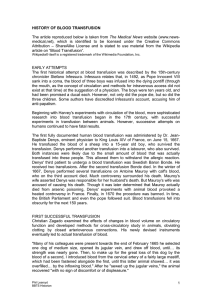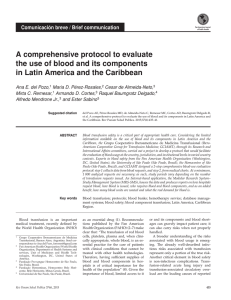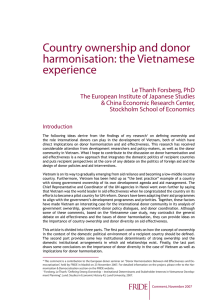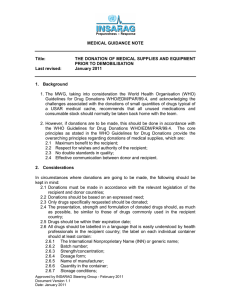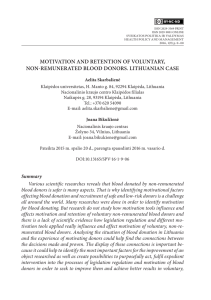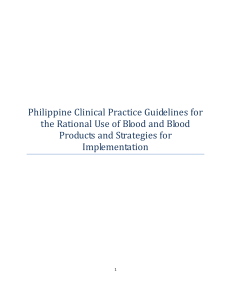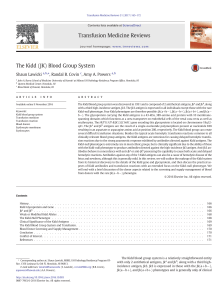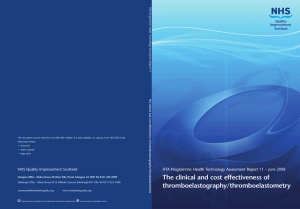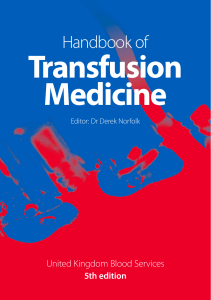Blood Safety - World Health Organization
Anuncio
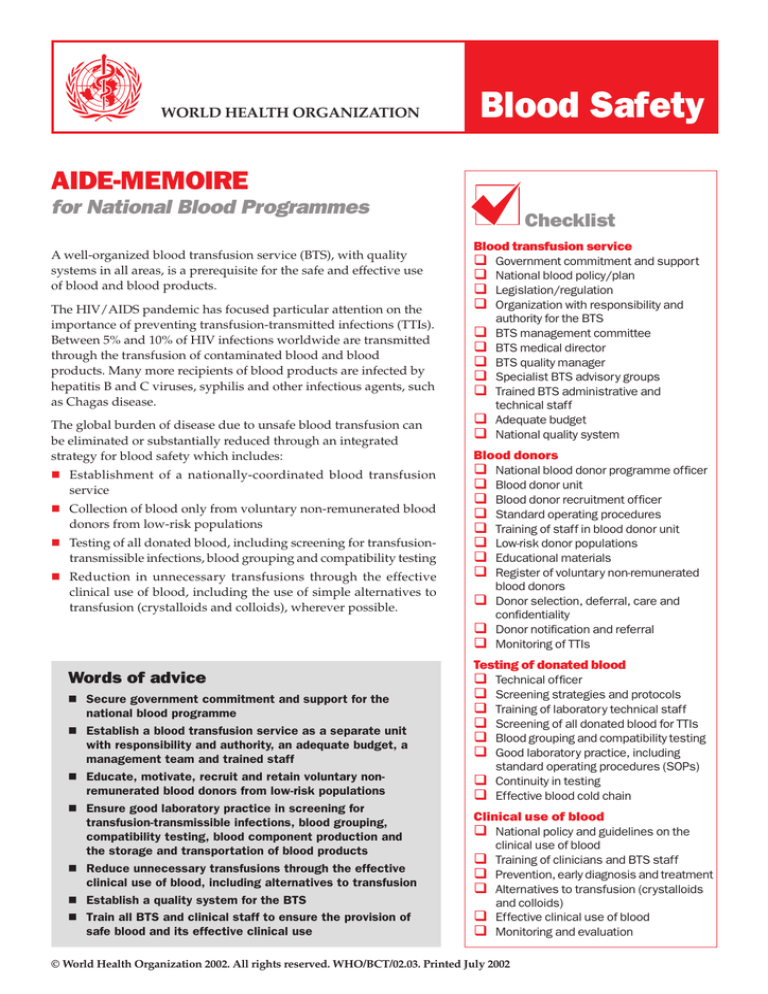
WORLD HEALTH ORGANIZATION Blood Safety AIDE-MEMOIRE for National Blood Programmes A well-organized blood transfusion service (BTS), with quality systems in all areas, is a prerequisite for the safe and effective use of blood and blood products. The HIV/AIDS pandemic has focused particular attention on the importance of preventing transfusion-transmitted infections (TTIs). Between 5% and 10% of HIV infections worldwide are transmitted through the transfusion of contaminated blood and blood products. Many more recipients of blood products are infected by hepatitis B and C viruses, syphilis and other infectious agents, such as Chagas disease. The global burden of disease due to unsafe blood transfusion can be eliminated or substantially reduced through an integrated strategy for blood safety which includes: n Establishment of a nationally-coordinated blood transfusion service n Collection of blood only from voluntary non-remunerated blood donors from low-risk populations n Testing of all donated blood, including screening for transfusion- transmissible infections, blood grouping and compatibility testing n Reduction in unnecessary transfusions through the effective clinical use of blood, including the use of simple alternatives to transfusion (crystalloids and colloids), wherever possible. Words of advice n Secure government commitment and support for the n n n n n n national blood programme Establish a blood transfusion service as a separate unit with responsibility and authority, an adequate budget, a management team and trained staff Educate, motivate, recruit and retain voluntary nonremunerated blood donors from low-risk populations Ensure good laboratory practice in screening for transfusion-transmissible infections, blood grouping, compatibility testing, blood component production and the storage and transportation of blood products Reduce unnecessary transfusions through the effective clinical use of blood, including alternatives to transfusion Establish a quality system for the BTS Train all BTS and clinical staff to ensure the provision of safe blood and its effective clinical use Checklist Blood transfusion service q Government commitment and support q National blood policy/plan q Legislation/regulation q Organization with responsibility and authority for the BTS q BTS management committee q BTS medical director q BTS quality manager q Specialist BTS advisory groups q Trained BTS administrative and technical staff q Adequate budget q National quality system Blood donors q National blood donor programme officer q Blood donor unit q Blood donor recruitment officer q Standard operating procedures q Training of staff in blood donor unit q Low-risk donor populations q Educational materials q Register of voluntary non-remunerated blood donors q Donor selection, deferral, care and confidentiality q Donor notification and referral q Monitoring of TTIs Testing of donated blood q Technical officer q Screening strategies and protocols q Training of laboratory technical staff q Screening of all donated blood for TTIs q Blood grouping and compatibility testing q Good laboratory practice, including standard operating procedures (SOPs) q Continuity in testing q Effective blood cold chain Clinical use of blood q National policy and guidelines on the clinical use of blood q Training of clinicians and BTS staff q Prevention, early diagnosis and treatment q Alternatives to transfusion (crystalloids and colloids) q Effective clinical use of blood q Monitoring and evaluation © World Health Organization 2002. All rights reserved. WHO/BCT/02.03. Printed July 2002 Key elements Establish a blood transfusion service It is the responsibility of governments to ensure a safe and adequate supply of blood. This responsibility may be delegated to a non-profit nongovernmental organization, but the BTS should be developed within the framework of the country’s health care infrastructure. The BTS requires government commitment and support and recognition as a separate unit with an adequate budget, management team and trained staff. Important activities in establishing a blood transfusion service include: Educate, motivate, recruit and retain low-risk blood donors High priority should be given to the elimination of family/replacement and paid blood donor systems, which are associated with a significantly higher prevalence of TTIs. Voluntary non-remunerated blood donors from low-risk populations who give blood regularly are the foundation of a safe and adequate blood supply. Important activities include: n Appointment of an officer responsible for the national blood donor programme n Establishment of a BTS unit responsible for donor education, motivation, recruitment and retention n Appointment of a designated blood donor recruitment officer n Preparation of SOPs in accordance with BTS guidelines n Training of staff in the blood donor unit n Identification of donor populations at low risk for TTIs n Development of educational materials n Establishment of a register of voluntary non-remunerated blood donors n Assurance of safe blood collection procedures, including donor selection and deferral, donor care and confidentiality n Formalization of government commitment and support n Appointment, when necessary, of specialist BTS advisory groups n Development of a national blood policy and plan n Appointment and training of staff experienced in each key aspect of the BTS n Development of necessary legislation/regulation for the BTS n Formation of an organization with responsibility and authority for the BTS n Formation of a BTS management committee n Appointment of a medical director n Appointment of a quality manager n Donor notification and referral for counselling n Monitoring of TTIs in the donor population. Test all donated blood The BTS should develop and maintain a national strategy for the testing of all donated blood and blood products, using the most appropriate and effective tests, and for good laboratory practice. Important activities include: n Appointment of a designated technical officer n Development of protocols for the testing, selection and evaluation of appropriate screening assays to be used at each site n Training of BTS laboratory technical staff n Screening of all donated blood for TTIs, including HIV, hepatitis viruses, syphilis and other infectious agents, such as Chagas disease n Blood grouping and compatibility testing n Good laboratory practice, with effective documentation, including standard operating procedures n Procurement, supply, central storage and distribution of reagents and materials to ensure continuity in testing at all sites n Maintenance of an effective blood cold chain for the storage and transportation of blood and blood products. n Development and implementation of a budgeting and finance system to ensure a sustainable blood programme through cost recovery and/or annual budget allocation n Establishment of national quality system, including guidelines, standard operating procedures, accurate records, monitoring and evaluation. Reduce unnecessary transfusions by effective clinical use of blood Blood transfusion has the potential for acute or delayed complications and the transmission of infection. The risks associated with transfusion can be reduced by minimizing unnecessary transfusions through the effective clinical use of blood and blood products and the appropriate use of simple alternatives to transfusion which are safer and more costeffective. Important activities include: n Development of a national policy and guidelines on the clinical use of blood n Training in the clinical use of blood for all clinicians involved in the transfusion process and for BTS staff n Commitment to the prevention, early diagnosis and treatment of conditions that could result in the need for transfusion (obstetrical complications, trauma and other causes of anaemia) n Availability of intravenous replacement fluids (crystalloids and colloids) for the correction of hypovolaemia n Availability of pharmaceuticals and devices to minimize the need for blood n Effective clinical use of blood and blood products in accordance with national guidelines n Monitoring and evaluation of the clinical use of blood. Department of Blood Safety and Clinical Technology World Health Organization 1211 Geneva 27, Switzerland Fax: +41 22 791 4836 [email protected] www.who.int/bct
